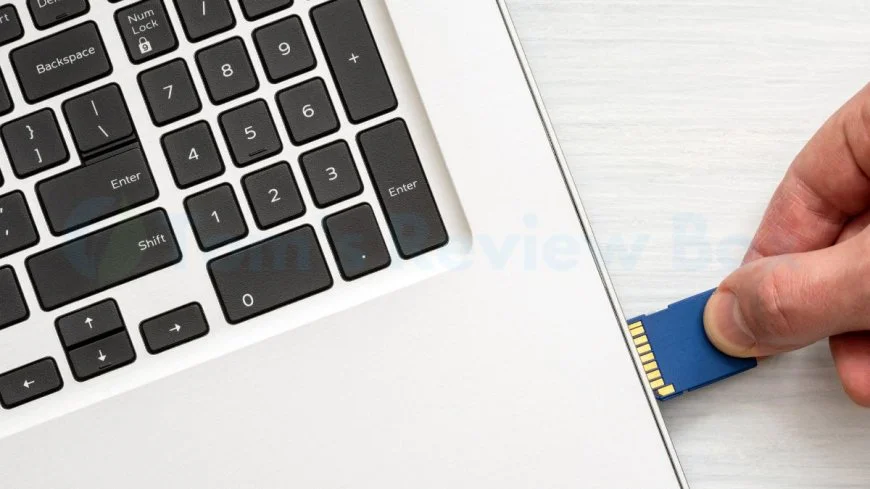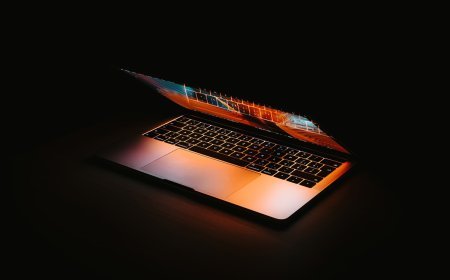How to Insert SD Card into MacBook Pro: Complete Guide
Learn how to use the SDXC slot on your Mac. Insert SD card into MacBook Pro with our complete guide.

Inserting an SD card into your MacBook Pro can be a breeze or a baffling task. While some find it straightforward, others struggle with the process due to problems. We are here to demystify this simple yet sometimes perplexing procedure for you. By following our step-by-step guide, you'll be able to seamlessly insert your SD card into your MacBook Pro in no time. Stay tuned for clear instructions and handy tips to make this contrasting experience a smooth one.
Key Takeaways
-
Understand the type and capacity of SD cards compatible with your MacBook Pro to ensure proper usage.
-
Prepare your MacBook Pro by locating the SD card slot and ensuring it is clean and free from debris before insertion.
-
Insert the SD card into your MacBook Pro correctly, aligning it with the slot and pushing it in until it clicks into place.
-
Safely eject the SD card from your MacBook Pro to prevent data loss or damage to the card.
-
Troubleshoot common issues like unrecognized SD cards by checking connections and restarting your MacBook Pro.
-
Fix 'Cannot Be Modified' errors on SD cards by adjusting the write-protection switch on the card if available.
Understanding SD Cards
Types Compatible
MacBook Pro models typically support SDXC cards. Supported types include MMC, Default Speed, High Speed, UHS-I, and UHS-II cards. Identify your Mac's compatibility with these different SDXC card types.
Capacity Limits
Different Mac models have varying capacity limits for SDXC cards. Check your Mac's maximum supported storage size to avoid issues. Exceeding capacity limits can lead to performance problems, so stay within the specified range.
Speed Classes
Familiarize yourself with the speed classes of SDXC cards available. Match your Mac's requirements with the appropriate speed class for optimal performance. For faster data transfer speeds, consider opting for higher speed classes.
Preparing Your MacBook Pro
Locating Slot
To insert an SD card into your MacBook Pro, first, find the SD card slot on your specific Mac model. Check its position—usually located on the side of the laptop—for easy access and insertion. Before proceeding, ensure the slot is clean from any dust or debris to avoid connection issues.
Checking Compatibility
Verify if your SDXC card is compatible with your MacBook Pro model before inserting it. Make sure the card meets all the required specifications outlined by Apple to prevent any potential damage to your device. Avoid using incompatible cards to maintain optimal performance and functionality.
Inserting SD Card
Step-by-Step Guide
To insert an SD card into your Mac, follow these steps carefully. First, locate the SD card slot on your MacBook Pro. Next, gently push the SD card into the slot until it clicks securely in place. Finally, confirm that the system recognizes the inserted card.
Understanding the process of inserting an SD card correctly is crucial to avoid any potential issues. Make sure to insert the card in the right orientation and with a steady hand. Take your time to ensure that the card is fully inserted and properly seated in the slot.
Avoid common mistakes during the insertion process by handling the SD card with care. Do not force the card into the slot or insert it at an angle. If you encounter any resistance while inserting the card, double-check its orientation before proceeding.
Ensuring Correct Orientation
Before inserting the SD card, always check for the correct orientation to prevent any damage. Align the metal contacts on the back of the card with those inside the slot on your MacBook Pro. This alignment ensures proper connectivity between the card and your device.
Prevent potential damage by ensuring that you insert the SD card in the right direction. The metal contacts should face down when you insert it into your MacBook Pro's SD card slot. Inserting it incorrectly can lead to connection issues and possible damage to both the card and your device.
Always handle SD cards with caution and avoid touching their metal contacts unnecessarily. Keeping these contacts clean and free from debris helps maintain a good connection between the card and your MacBook Pro's internal components.
Ejecting SD Card Safely
Using Finder
Utilize Finder to access and manage your SD card files. This tool allows you to navigate through different folders on your MacBook Pro. By using Finder, you can easily locate the SD card icon and safely eject it when needed. Explore the features of Finder for efficient file handling, ensuring that you safely remove the SD card without any data loss. With Finder, you can seamlessly transfer data between your Mac and the SD card.
Shortcut Methods
Discover shortcut methods for ejecting an SD card quickly and conveniently. These shortcuts provide a faster way to remove the SD card from your MacBook Pro without going through multiple steps. By utilizing these quick shortcuts, you can save time and ensure that the ejection process is done safely. Remember to always eject the SD card properly to prevent any potential data corruption or damage to the card itself.
Troubleshooting Common Issues
Card Not Mounting
If your SD card is not mounting, try these steps for effective troubleshooting. Address mounting issues promptly to avoid data loss.
-
Check the card reader connection.
-
Clean the SD card and the port gently.
-
Restart your MacBook Pro to reattempt mounting.
Resolving mounting problems involves ensuring a proper connection, cleanliness, and system restart.
Read/Write Errors
To fix read/write errors with your SD card, troubleshoot common issues affecting data transfer. Ensure smooth data transfer by addressing read/write errors promptly.
-
Verify the compatibility of the SD card.
-
Update macOS and relevant drivers.
-
Use Disk Utility to repair disk permissions.
Troubleshooting read/write errors includes checking compatibility, updating software, and using Disk Utility for repairs.
Fixing 'Cannot Be Modified' Error
Checking Lock Switch
When encountering the 'Cannot Be Modified' error, check the lock switch on the SD card. Understand that this switch is for write protection. Unlock it to allow modifications to the card if necessary.
Formatting Tips
For optimal performance, consider some formatting tips when inserting an SD card into your MacBook Pro. Follow guidelines to ensure correct formatting, enhancing storage efficiency through proper techniques.
Optimizing SD Card Usage
Storage Expansion Tips
When it comes to expanding storage on your MacBook Pro, utilizing SD cards is a cost-effective solution. Maximize storage capacity by inserting additional SD cards into your device. Consider using multiple cards to have various storage options available at your disposal.
-
Inserting multiple SD cards allows for flexible storage management.
-
Easy access to different types of data with separate cards.
-
Affordable way to expand storage without replacing internal components.
Speed Optimization
To ensure optimal performance, it's essential to optimize the speed of your inserted SD card. By adjusting settings on your MacBook Pro, you can significantly enhance the data transfer speeds when using an SD card. Experience faster data access through effective speed optimization techniques.
-
Adjusting settings such as buffer size can improve data transfer rates.
-
Use high-quality SD cards with faster read and write speeds for better performance.
-
Regularly formatting the SD card can help maintain its speed over time.
Maintaining SD Cards
Regular Formatting
Regularly format your SD card to maintain performance. Prevent data corruption by formatting the card periodically. Follow best practices for maintaining your SD card.
Safe Removal Practices
Practice safe removal procedures for ejecting an SD card. Avoid data loss by safely removing the card. Follow proper steps to prevent damage during removal.
Advanced Tips and Tricks
Using External Readers
External readers are essential for accessing SD cards on a Mac. They provide a convenient way to transfer data quickly. By using external readers, you can easily access the contents of your SD card without any hassle. This method is especially useful when your MacBook Pro lacks an SD card slot.
Benefits of using external card readers include compatibility with various types of SD cards. These readers also offer faster data transfer speeds compared to directly connecting the SD card to your computer. External readers are portable and can be used across multiple devices, adding to their versatility.
Easily transfer data using external readers for convenience. This process eliminates the need for adapters or additional equipment, simplifying the task of transferring files between your Mac and the SD card. With external readers, you can seamlessly manage and access your data whenever needed.
Enhancing Performance
Enhance your Mac's performance by utilizing SD cards effectively. By inserting an SD card into your MacBook Pro, you can expand its storage capacity without compromising speed. This allows you to store more files and applications without slowing down your device.
Utilize SD cards to improve both storage and speed on your Mac. The additional storage space provided by an inserted SD card enables you to keep more files locally on your device, reducing the strain on its internal storage. Moreover, certain applications can benefit from improved speed when running off an inserted SD card.
Experience enhanced functionality by integrating SD cards into your workflow. Whether you're a content creator needing extra storage for large media files or a professional requiring quick access to important documents, utilizing SD cards effectively can significantly boost productivity. By optimizing how you use SD cards with your MacBook Pro, you can streamline your workflow and enhance overall performance.
Final Remarks
You now have the knowledge to seamlessly insert and manage SD cards on your MacBook Pro. Remember to handle them with care, follow the steps for insertion and ejection diligently, and troubleshoot any issues effectively. By optimizing your SD card usage and maintaining them properly, you ensure longevity and efficient performance.
Take charge of your digital storage needs by implementing these tips and tricks. Explore the advanced functionalities available and make the most out of your MacBook Pro's capabilities. By mastering these skills, you enhance your overall user experience and productivity. Keep learning and adapting as technology advances, staying ahead in the digital realm.
Frequently Asked Questions
How do I know if my MacBook Pro has an SD card slot?
Your MacBook Pro has an SD card slot if it is a model released before 2016. Check the side of your laptop for a small slot labeled "SD" or "SDXC."
Can I insert a microSD card directly into my MacBook Pro?
No, you cannot insert a microSD card directly into a MacBook Pro. You will need an adapter that allows you to insert the microSD card into the adapter first, then insert the adapter into the SD card slot on your MacBook Pro.
Do I need to format my SD card before inserting it into my MacBook Pro?
If your SD card is brand new, it's recommended to format it in the exFAT file system for compatibility with both Mac and Windows. If your SD card already contains data, ensure you have backed up the data before formatting.
How can I safely eject the SD card from my MacBook Pro?
To safely eject the SD card from your MacBook Pro, click on the Finder icon in the Dock, locate the SD card under Devices, right-click on it, and select Eject. Wait for the notification that it is safe to remove before physically taking out the SD card.
What should I do if my MacBook Pro does not recognize the inserted SD card?
If your MacBook Pro does not recognize the inserted SD card, try restarting your laptop with the SD card inserted. If that doesn't work, check for any debris in the SD card slot and ensure the card is properly inserted. You may also try using a different SD card to troubleshoot further.
What's Your Reaction?







































![MacBook Pro M5: All the features and specs you need to know [LEAKS REVEALED]](https://tomsreviewbox.com/uploads/images/202502/image_430x256_67bd6d7cd7562.jpg)



























